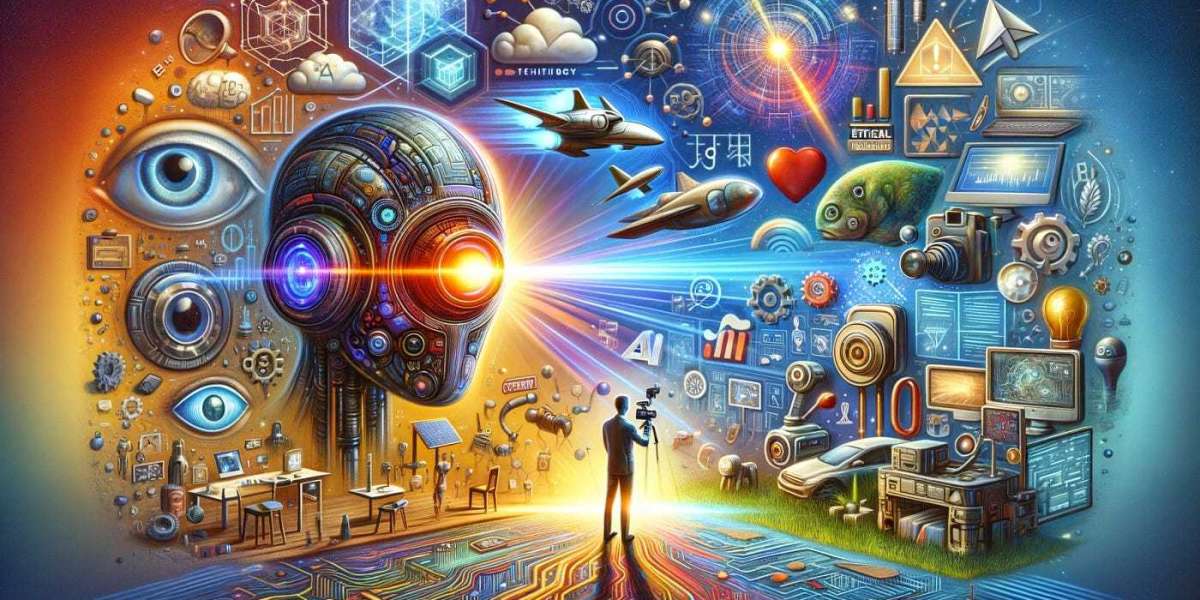Artificial Intelligence (AI) image generation is rapidly transforming various industries by offering innovative solutions and unprecedented capabilities. From enhancing creative processes to improving operational efficiencies, AI-generated images are finding applications across a broad spectrum of fields. This blog explores the diverse applications of AI image generation, shedding light on how this technology is revolutionizing industries and changing the way we interact with visual content.
1. E-Commerce and Retail
AI image generation is revolutionizing the e-commerce and retail sectors by enhancing product visualization and personalizing the shopping experience. Here’s how:
Virtual Try-Ons: AI allows customers to visualize how clothes, accessories, or makeup will look on them through virtual try-on solutions. By generating realistic images of products on users, AI enhances the online shopping experience, reducing the uncertainty associated with buying products without physical interaction.
Product Customization: AI can generate images of customized products, enabling customers to see their personalized items before purchase. Whether it’s engraving a name on a piece of jewelry or designing custom sneakers, AI helps customers visualize their unique creations.
Augmented Reality (AR) Integration: AI-generated images are crucial for AR applications in retail. For example, furniture retailers use AI to help customers visualize how pieces will look in their homes, improving the decision-making process and reducing return rates.
2. Healthcare and Medical Imaging
In the healthcare sector, AI image generation is making significant strides in improving diagnostics, treatment planning, and medical training.
Enhanced Diagnostic Imaging: AI algorithms generate high-resolution medical images, aiding in the early detection and diagnosis of diseases. AI can improve the clarity and detail of MRI, CT, and X-ray images, helping radiologists identify anomalies more accurately.
Synthetic Data for Training: AI-generated images are used to create synthetic medical datasets for training healthcare professionals. These datasets can include a wide range of conditions and scenarios, enhancing the training experience and preparing medical staff for real-world challenges.
Surgical Planning: AI generates detailed 3D models of patients' anatomy, aiding surgeons in planning complex procedures. These models provide a comprehensive view of the surgical site, improving precision and outcomes.
3. Entertainment and Media
The entertainment and media industries are leveraging AI image generation to create stunning visual effects, realistic characters, and immersive environments.
Visual Effects in Film and TV: AI generates realistic visual effects, reducing the need for costly and time-consuming practical effects. From creating lifelike creatures to generating entire environments, AI enhances the visual storytelling capabilities of filmmakers.
Virtual Actors: AI can create realistic virtual actors, allowing filmmakers to bring back historical figures or create entirely new characters. This technology opens up new possibilities for storytelling and casting.
Game Development: AI-generated images are used in game development to create realistic characters, environments, and assets. AI can also generate procedural content, such as landscapes and levels, reducing development time and costs.
4. Art and Design
AI is transforming the fields of art and design by providing new tools for creativity and innovation.
Generative Art: Artists use AI algorithms to create generative art, exploring new forms and styles. AI can analyze existing artworks and generate new pieces that blend different artistic influences, pushing the boundaries of creativity.
Graphic Design: AI assists graphic designers by generating design elements, suggesting layouts, and even creating entire compositions. This helps designers work more efficiently and experiment with new ideas.
Fashion Design: AI generates fashion designs based on trends, historical styles, or user preferences. Fashion designers can use AI to explore new concepts, create virtual prototypes, and streamline the design process.
5. Marketing and Advertising
In marketing and advertising, AI-generated images enhance campaigns by providing personalized and engaging visual content.
Targeted Advertising: AI generates personalized advertisements based on user data and preferences. By creating images tailored to specific demographics, AI increases engagement and conversion rates.
Content Creation: Marketers use AI to generate high-quality images for social media, websites, and other digital platforms. AI can produce a large volume of content quickly, ensuring that marketing campaigns remain fresh and relevant.
Product Visualization: AI-generated images help visualize products in various contexts, highlighting features and benefits. This is particularly useful for complex products that require detailed explanations.
6. Real Estate and Architecture
AI image generation is making waves in real estate and architecture by providing realistic visualizations and improving design processes.
Virtual Tours: AI generates virtual tours of properties, allowing potential buyers to explore homes remotely. These tours provide a realistic and immersive experience, helping buyers make informed decisions.
Architectural Visualization: Architects use AI to create detailed visualizations of buildings and spaces. AI can generate realistic renderings of proposed designs, helping clients understand the final outcome.
Interior Design: AI assists interior designers by generating images of different design concepts. Clients can visualize various styles and layouts, making it easier to choose the best options for their spaces.
7. Education and Training
AI image generation is enhancing education and training by providing realistic and interactive visual content.
Educational Content: AI generates images and animations that illustrate complex concepts, making learning more engaging and effective. For example, AI can create detailed diagrams of scientific processes or historical events.
Virtual Labs: In STEM education, AI-generated images power virtual labs and simulations, allowing students to conduct experiments and explore concepts in a safe and controlled environment.
Training Simulations: AI creates realistic training simulations for various professions, from medical procedures to emergency response. These simulations provide hands-on experience and improve skill development.
8. Social Media and Communication
On social media, AI-generated images are enhancing user interaction and content creation.
Filters and Effects: AI generates filters and effects that users can apply to their photos and videos. These features enhance the visual appeal of social media content and increase user engagement.
Content Generation: Social media influencers and content creators use AI to generate images and graphics for their posts. AI helps maintain a consistent visual style and produces content quickly, keeping followers engaged.
Personalized Content: AI analyzes user behavior and preferences to generate personalized visual content, making social media feeds more relevant and engaging.
9. Environmental and Scientific Research
AI image generation is contributing to environmental and scientific research by providing detailed visualizations and data analysis.
Environmental Monitoring: AI generates images from satellite data, helping monitor environmental changes such as deforestation, climate change, and urbanization. These images provide valuable insights for researchers and policymakers.
Scientific Visualization: AI creates detailed visualizations of scientific data, from molecular structures to astronomical phenomena. These visualizations help researchers understand complex data and communicate findings effectively.
Wildlife Conservation: AI generates images for wildlife monitoring and conservation efforts. For example, AI can analyze camera trap images to identify and track animal populations, aiding in conservation planning.
Conclusion
The applications of AI image generation are vast and varied, spanning numerous industries and transforming the way we create and interact with visual content. From enhancing e-commerce and healthcare to revolutionizing entertainment and art, AI-generated images are unlocking new possibilities and efficiencies. As AI technology continues to advance, its impact on image generation will only grow, offering even more innovative solutions and applications. Embracing these advancements will enable businesses and individuals to stay ahead of the curve, harnessing the power of AI to create compelling, personalized, and impactful visual experiences.








